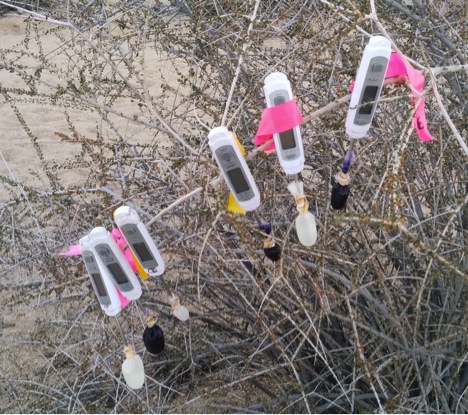Day 10. Project day.
Despite arriving at Joshua Tree National Park the day before, we are already divided into four teams in order to develop a research project in this unfamiliar environment. The instructions are given: twenty-four hours to find a pertinent research question, collect meaningful data, analyze the results, and prepare a PowerPoint presentation. This will be quite a challenge; usually these are the instructions for a term project and now the teachers want us to undertake this in a single day!?
Ready. Set. Go.
Six plastic containers filled with equipment are unloaded from the trailer and placed on a nearby picnic table. The groups quickly gather around and begin to negotiate who gets what. Not surprisingly, data loggers are a hot commodity; these devices allow us to automatically measure temperature at an interval of our choosing and can subsequently be plugged into a computer to retrieve this data.
While three of the teams discuss how to distribute the twelve data loggers available, team one (Sonia, Yifu, LeeAnn, Thomas and Alexis) is intrigued by the big black carpenter bees buzzing around the site and wonder whether the bee’s dark colour affects their warming speed. Instead of using the high-tech data loggers like everyone else, team one decides to cut the fingers off both black and white latex gloves, fill them with water, and attach them to meat thermometers. These clever proxies for bee bodies are hung outside next to each other in order to monitor their heating rate. Interestingly, the simulated black bees heat up much faster than the white ones. By monitoring bee activity out in the field, they also discover that carpenter bees are most active early in the morning and become less active as the ambient temperature rises―exactly what was expected from these dark-bodied organisms.
On the other hand, team two (Amanda, Anne-Sophie, Matthew, Sean and Duncan) is curious about the temporal thermal regime of a granite basking rock used by reptiles in relation to the atmosphere and soil. In addition to data loggers, the team also uses the thermal imager to take readings at the four cardinal compass points of the rock every hour through the night and day. Their results show that there is a similarity between the rock, air and ground temperature in that they all decrease and increase at the same time of day: sunrise and sunset. They also observe that the temperature of the rock cools down faster than the ground, possibly making it a preferable place to hang out for reptiles. Lastly, using the thermal imager the team notices that temperature differs at each cardinal point by reaching maximum temperatures at different points of the day. With different aspects of the rock heating at different time periods, reptiles may prefer different sides of the rocks at different times of the day. One big science reality check taught the group that sometimes research requires an all-nighter in order to get the information needed.
While team two was looking at rocks, team three (Claire, Dylan, Pauline, Jasmin and Vanessa) revisit the Cotton Oasis which we had seen the day before. They wonder if there is a difference between the two opposite facing slopes, one being rocky and one being an oasis. They also want to know what environmental factors caused the possible difference. They look at floral diversity, faunal diversity, slope angle and direction, soil composition, and air and soil temperature. In the end they find that the soil and slopes didn’t significantly differ, the floral diversity differed, and temperature differed significantly.
Team four (Patrick, Maxine, John, Jordan and Anthony) wanders to Wood Spring and notice a small patch of cattails (Typha sp.) in the desert. This prompts them to investigate the thermal properties of springs in desert ecosystems and their effect on organism abundance. Using data loggers, they are able to demonstrate that areas with surface water have less temperature variations than dry areas. Additionally, since it is commonly stated that desert organisms seek shade in the hottest part of the day, they compare the importance of minimum temperature to water. Interestingly, as the day progresses the wet patch becomes warmer than the nearby shaded site but maintains the highest organism abundance, once again alluding to the importance of water in desert ecosystems.
After twenty-four hours of brainstorming, data gathering, interpretation, and preparation, the exhausted but enthused teams present their projects to the class. Students got a taste of field work in the desert and learned that science can sometimes be physically demanding, with intense heat and little sleep. However, we also learned that research can be a lot of fun and can teach us many things about the world around us.



On most mornings, I open my computer with my morning coffee to see what you guys are up to. Good job teams on your 24 hour Powerpoint presentations; that was very interesting with not much time for preparation! Good challenge.